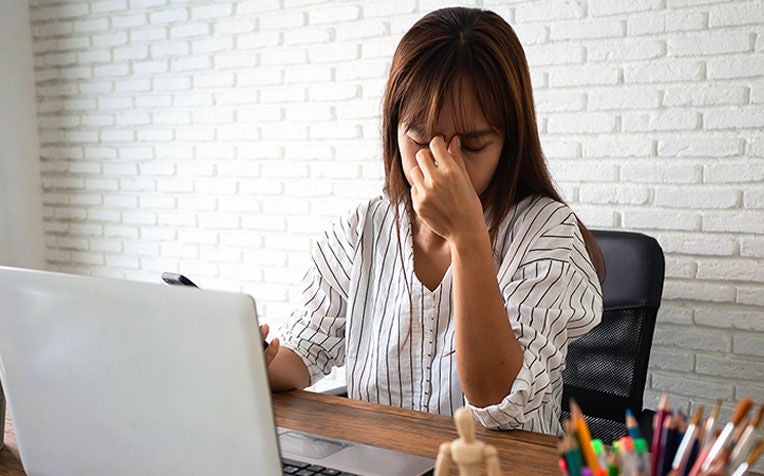
Digital eye strain (computer vision syndrome) is often caused by prolonged use of digital devices without taking proper eye care. It can lead to tired eyes, headahces, blurred vision and dry eyes.
Digital eye strain, also known as Computer Vision Syndrome, is a group of eye and vision related problems resulting from prolonged use of digital devices such as computers, tablets and mobile phones.
Based on a 2015 study, Singapore millennials (aged 16 to 30) spend about 3.4 hours per day on their mobile phone, excluding hours spent in front of the TV or computer. This number is likely to have increased with the COVID-19 pandemic and as more time is spent indoors.
“Excessive amounts of screen time can lead to eye strain, headaches, blurred vision and dry eyes,” explained Dr Tan Licia, Consultant from the Oculoplastic Department at Singapore National Eye Centre (SNEC), a member of the SingHealth group.
“However, uncorrected vision problems such as long-sightedness (hyperopia), astigmatism and presbyopia (commonly known as ‘Lao Hua’) can contribute to a higher risk of more severe symptoms,” Dr Tan added.
Fortunately, most symptoms of digital eye strain are temporary and should go away with the reduction of screen time. However, recurring symptoms should be properly managed as they could worsen with the continuation of prolonged screen time.
8 Easy ways to prevent eye strain from excessive screen time
Digital eye strain can easily be prevented and managed by following healthy eye habits and making small adjustments to the work area:
1. Ensure proper distance from the monitor screen
Arrange the computer within an arm’s length away (20 to 28 inches). The top of the screen should be positioned at or just below eye level while the centre of the screen should be 10 to 15 degrees below eye level.
2. Place reference materials closer to you
Place printed materials needed for referencing above the keyboard and below the monitor. Alternatively, place them on a document holder positioned as close to the monitor as possible, so that looking up at the screen and back down at the desk is not required.
3. Get a proper chair and maintain good posture
Not all chairs are created equal. Use ergonomic chairs as they have comfortable paddings which conform to the body. When sitting, rest feet flat on the floor and support arms using elbow rests. Wrists should not be rested on the keyboard when typing.
4. Adjust screen brightness and contrast
Match the screen to the same level of brightness as the room you are in. Screens that are brighter than the surroundings require the eyes to work harder, thus causing eye strain. Another option you can consider is to use a screen glare filter. Also, adjust screen contrast so that it is at a comfortable level for your eyes.
5. Pay attention to your room lighting
Ensure that the lighting of the room is not too dim or too bright. You should also avoid glare from overhead lights or windows. If the table that your computer is on is located close to a window, position the table perpendicular to the window to avoid backlighting or glare and reflection of sunlight from opposite the screen.
6. Don’t forget to take frequent eye breaks
A simple way to remember is to observe the “20-20-20” rule. After 20 minutes of screen time, look away from the screen at something 20 feet (about 6 metres) away for 20 seconds. Do this throughout the day. Better still, take the opportunity to go for a walk or do some stretching to relax your neck, shoulder and back muscles – frequent moving is key to better overall health!
7. Beware of dry eyes
Dry eyes (dry eye syndrome) is another condition that can arise from digital eye strain. When viewing a screen for a long period of time, ensure that the air-conditioner or fan is not blowing directly at your face as this will dry your eyes. To avoid dry eyes, apply lubricating eye drops and blink frequently to keep your eyes moist.
8. Get your eyes checked regularly
Go for regular eye check-ups to ensure that your prescriptions are up to date. Also, get eyewear that is designed for close-up viewing of computer screens to minimise eye strain when working. Lastly, glasses are preferred to contact lenses when working on screen as they are less likely to cause eye strain and dryness.
As you can see, taking simple steps can help go a long way to preventing eye strain. Take good care of your eyes so that you can continue to enjoy quality of life in your old age.
To learn more about your eyes and common eye conditions, click here.
Ref: J22
Check out other articles on eye care:
Cataract: Causes, Symptoms and Treatment
Glaucoma: Beware of the Silent Thief of Sight
AMD (Age-Related Macular Degeneration): What You Need to Know
Contributed by















 Get it on Google Play
Get it on Google Play